
Applied General Topology
Scope & Guideline
Unveiling the Potential of General Topology
Introduction
Aims and Scopes
- Ideal Topological Spaces:
Research in this area delves into the properties and dimensions of ideal topological spaces, exploring their unique characteristics and applications in broader mathematical contexts. - Fixed Point Theorems:
A significant portion of the journal's articles discusses various fixed point theorems, including those for nonexpansive mappings, cyclic contractions, and fuzzy metric spaces, showcasing their relevance in functional analysis and geometry. - Topological Groups and Structures:
The journal publishes work on the intersections of topology and algebra, particularly focusing on topological groups, their automorphisms, and implications for other mathematical structures. - Digital Topology:
This area explores topological concepts in digital settings, including digital homotopy and homology theories, which are increasingly important in computer science and discrete mathematics. - Metric and Fuzzy Spaces:
Research on metric spaces, including noncommutative and fuzzy metrics, illustrates the journal's commitment to exploring various generalizations and applications of traditional metric theories. - Contraction Mappings and Applications:
Many papers investigate different types of contraction mappings and their applications, particularly in the context of Banach and fuzzy metric spaces, emphasizing their utility in solving differential equations.
Trending and Emerging
- Fuzzy and Probabilistic Topologies:
There is a growing interest in fuzzy metric spaces and probabilistic approaches to topology, indicating an emerging trend that aligns with contemporary applications in data science and uncertainty modeling. - Advanced Fixed Point Theorems:
Recent publications are increasingly focused on advanced fixed point theorems, particularly those that explore new classes of mappings and their applications in various mathematical contexts, highlighting a trend toward innovation in this area. - Topological Dynamics:
The exploration of dynamical systems within topological contexts is gaining traction, reflecting an interdisciplinary approach that connects topology with dynamical systems theory. - Digital and Discrete Topology:
There is an emerging trend in digital topology and related discrete structures, which is increasingly relevant in computational fields and theoretical computer science. - Connections between Algebra and Topology:
Research that bridges algebraic structures with topological concepts is on the rise, suggesting a trend towards integrated approaches that enrich both fields.
Declining or Waning
- Classical Topological Properties:
Topics related to classical topological properties, such as compactness and connectedness, appear less frequently, potentially indicating a waning interest in foundational aspects in favor of more applied or complex structures. - Traditional Metric Spaces:
Research specifically focused on traditional metric spaces is decreasing, possibly due to the rise of more generalized spaces like fuzzy or probabilistic metric spaces, which offer broader applications. - Elementary Fixed Point Theorems:
Basic fixed point theorems, particularly those with straightforward applications, are becoming less common, as researchers gravitate towards more sophisticated and generalized frameworks.
Similar Journals

PUBLICATIONES MATHEMATICAE DEBRECEN
Connecting Scholars through High-Quality Mathematical ResearchPublicationes Mathematicae Debrecen is a renowned international journal published by the University of Debrecen, Institute of Mathematics, situated in Hungary. This journal, with both ISSN 0033-3883 and E-ISSN 2064-2849, has established itself in the field of mathematics since its inception, with coverage extending from 1997 to 2024. Recognized for its rigorous academic standards, it currently holds a Q3 ranking in the mathematics (miscellaneous) category for 2023 and ranks at the 42nd percentile among general mathematics journals in Scopus. Publicationes Mathematicae Debrecen aims to disseminate high-quality research across various areas of mathematics, contributing to the advancement of knowledge and practice in this dynamic field. Although it is not an open-access journal, its readers can access a wealth of scholarly work that addresses both theoretical and applied mathematical issues, making it an invaluable resource for researchers, professionals, and students alike.
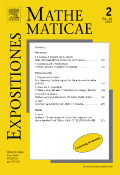
EXPOSITIONES MATHEMATICAE
Connecting Scholars Through Mathematical InsightsEXPOSITIONES MATHEMATICAE, published by Elsevier GmbH, stands as a significant journal in the realm of mathematics, catering primarily to researchers, professionals, and students. With an ISSN of 0723-0869 and an E-ISSN of 1878-0792, this journal has made its mark in the academic community, boasting a Q2 classification in the miscellaneous mathematics category for 2023, illustrating its prominence within its field. The journal addresses a diverse scope of mathematical topics, encouraging the publication of original research and innovative theories while maintaining rigorous academic standards. As it converges from 2004 to 2024, EXPOSITIONES MATHEMATICAE continues to be an essential resource for advancing mathematical knowledge and fostering scholarly communication, despite being a non-open-access publication. Its location in Munich, Germany further anchors it within a rich intellectual tradition, providing accessibility for the mathematical community worldwide.

Journal of Analysis
Empowering Ideas in Number Theory and GeometryThe Journal of Analysis, published by SPRINGERNATURE, serves as a crucial platform for disseminating advanced research in the fields of mathematics, particularly focusing on Algebra, Number Theory, Analysis, Applied Mathematics, Geometry, Topology, and Numerical Analysis. Since its inception in 2016, this journal has aimed to foster knowledge-sharing and innovation among researchers, professionals, and students. Boasting a diverse scope and a commitment to high-quality research, the journal is indexed in various categories with rankings that reflect its growing influence, particularly in Algebra and Number Theory (Q4), Analysis (Q3), and Applied Mathematics (Q3), among others. With an ISSN of 0971-3611 and E-ISSN of 2367-2501, it offers insightful articles that contribute to the ongoing discourse in mathematics. The journal is located in Germany, ensuring a European perspective while also welcoming global contributions. Researchers seeking to enhance their understanding and impact in their respective fields will find this journal an invaluable resource.

Facta Universitatis-Series Mathematics and Informatics
Inspiring Excellence: A Platform for Transformative ResearchFacta Universitatis-Series Mathematics and Informatics is a prestigious interdisciplinary journal published by UNIV NIS that emphasizes the integration of mathematical theories and computational methods essential for advancements in various scientific fields. With the ISSN 0352-9665 and E-ISSN 2406-047X, this journal serves as a vital platform for researchers and professionals to disseminate cutting-edge findings related to mathematics and informatics. As an open-access journal, it aims to enhance the visibility and accessibility of high-quality research, fostering collaboration among scholars globally. The journal's commitment to excellence is evident in its rigorous peer-review process, which ensures that only the most impactful and innovative research papers are published. Set against the backdrop of its esteemed Serbian institution, Facta Universitatis not only aims to contribute to the global academic discourse but also to inspire the next generation of mathematicians and computer scientists. As the field continues to evolve, this journal plays a crucial role in shaping the future landscape of mathematics and informatics.
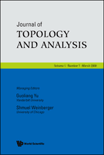
Journal of Topology and Analysis
Fostering Collaboration in Advanced Mathematical DisciplinesJournal of Topology and Analysis, published by WORLD SCIENTIFIC PUBL CO PTE LTD, is a distinguished peer-reviewed journal that focuses on advanced topics in mathematics, specifically within the fields of topology and analysis. Established in 2009 and running through 2024, the journal is based in Singapore and strives to present cutting-edge research that contributes to the mathematical community's understanding of geometric structures and analytical theories. Holding a respected position with a Q2 ranking in Analysis and a Q3 ranking in Geometry and Topology according to the 2023 category quartiles, the journal is indexed in Scopus, where it ranks #49 in Geometry and Topology and #118 in Analysis, showcasing its significance in the scholarly landscape. The Journal of Topology and Analysis aims to foster interdisciplinary collaboration by providing a platform for researchers, professionals, and students to share innovative findings and insights. Although it does not currently offer open access, its contributions are vital for advancing knowledge in these mathematical domains.
PUBLICATIONS OF THE RESEARCH INSTITUTE FOR MATHEMATICAL SCIENCES
Pioneering Insights into MathematicsPublications of the Research Institute for Mathematical Sciences, ISSN: 0034-5318, E-ISSN: 1663-4926, is a distinguished academic journal published by the European Mathematical Society. Since its inception in 1969, this journal has emerged as a pivotal platform for disseminating high-quality research in the field of mathematics, achieving a notable position in the top quartile (Q1) of the Mathematics (miscellaneous) category as of 2023. With a current Scopus Rank of #121 out of 399, placing it within the 69th percentile for general mathematics, the journal serves as an essential resource for researchers, professionals, and students alike. It aims to foster the advancement of mathematical science through innovative research and comprehensive studies that encourage scholarly dialogue and collaboration. While access options may vary, the journal remains committed to enhancing the visibility and impact of mathematics research on a global scale. Based in Germany, at the Technische Universität Berlin, it continues to uphold a legacy of academic excellence and rigor in mathematical inquiry.

Kyoto Journal of Mathematics
Unleashing potential through cutting-edge mathematical research.Kyoto Journal of Mathematics is a premier academic publication dedicated to advancing the field of mathematics, published by DUKE UNIVERSITY PRESS. Established in 1996, this journal serves as a vital platform for sharing innovative research and breakthrough studies across various mathematical disciplines. The journal has consistently maintained a prestigious Q1 ranking in the category of Mathematics (miscellaneous) as of 2023, reflecting its significant impact and contribution to the mathematical community. With its Open Access policy, the Kyoto Journal of Mathematics ensures that groundbreaking research is easily accessible to a global audience, fostering collaboration and knowledge dissemination among researchers, professionals, and students alike. The journal's commitment to excellence and relevance in mathematical research is underscored by its extensive archive of published works and its continuous engagement with contemporary mathematical challenges. This makes the journal an essential resource for anyone seeking to stay abreast of current trends and advancements in the field.
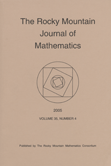
ROCKY MOUNTAIN JOURNAL OF MATHEMATICS
Fostering Collaboration in Diverse Mathematical FieldsROCKY MOUNTAIN JOURNAL OF MATHEMATICS, published by the Rocky Mountain Math Consortium, serves as a critical platform for researchers and practitioners in the field of mathematics since its inception in 1971. With a notable presence in the academic community, this journal covers a broad spectrum of mathematical disciplines, positioning itself in the Q2 category for Mathematics (miscellaneous) as of 2023. Despite being a subscription-based journal, it is recognized for its rigorous peer-review process and contributions to theoretical and applied mathematics, helping to advance knowledge and foster collaboration among mathematicians. The journal's ISSN number is 0035-7596 and its E-ISSN is 1945-3795, reflecting its commitment to accessibility and dissemination of high-quality research. Based in Tempe, Arizona, at Arizona State University, the journal continues to play an important role in shaping contemporary mathematical discourse through well-researched articles and innovative studies, aiming to bridge gaps between various mathematical subfields and engage a diverse audience, including students and established researchers alike.

HOUSTON JOURNAL OF MATHEMATICS
Elevating the Standards of Mathematical InquiryHOUSTON JOURNAL OF MATHEMATICS, published by the University of Houston, serves as a valuable platform for disseminating significant findings in the field of mathematics, specifically within the realm of miscellaneous mathematics. Despite its current categorization in Q4 for 2023, the journal plays a crucial role in fostering academic discussion and exploration among researchers, professionals, and students alike. With its ISSN 0362-1588, the journal has been publishing original research since 1996, with a recent gap filled from 2022 to 2023, thereby continuing to contribute to the mathematical community. While it does not currently offer open access options, the journal's commitment to quality research maintains its relevance within the field and invites submissions that can elevate its standing. Located in the vibrant city of Houston, Texas, the journal not only emphasizes theoretical advancements but also encourages applied mathematical research that intersects with other disciplines, enhancing its significance and reach.
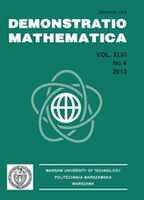
Demonstratio Mathematica
Championing Open Access in Mathematical ResearchDemonstratio Mathematica, published by DE GRUYTER POLAND SP Z O O, is an esteemed open-access journal in the field of mathematics, with an ISSN of 0420-1213 and E-ISSN 2391-4661. Established in 1996 and providing open access since 2009, it has become a vital platform for disseminating innovative research and advancements in various areas of mathematics. With a commendable Scopus ranking of 85/399 in General Mathematics and a 2023 Category Quartile of Q2, it stands at the forefront of the mathematical community, demonstrating a significant impact within the top 78th percentile. The journal aims to foster a deeper understanding and appreciation of mathematical concepts and their applications, catering to both seasoned researchers and emerging scholars. Located in Warsaw, Poland, Demonstratio Mathematica not only enriches the academic discourse but also strengthens collaborative efforts within the international mathematics community, making it an essential resource for those seeking to expand their knowledge and research output.